A “Dual Vector Foil” is a “universal regular weapon” that Liu Cixin invented in his renowned science fiction series The Three-Body Problem. While the three-dimensional universe is hit by a “dual vector foil”, it will cause a large amount of loss in energy and material in some dimension, which might lead to the collapse of a two-dimensional universe and further the death of a three-dimensional universe. Liu Cixin invented a vast vision from this perspective of classical physics and the ideal behind this can also be found and shared in Xu Bing’s recently unveiled exhibition “Book from the Ground—Pop-up Book” from a logic layer or even imagination.

Installation View of “Book from the Ground—Pop-up Book”
“Turn the real world into a two-dimensional plane,” was quoted from a message on Weibo posted after the opening of the exhibition by Chi Liping, who is in charge of Tokyo Gallery + BTAP in Beijing. Xu Bing believed that this may be an appropriate description of this exhibition. The so-called “two-dimensional plane” was realized by the special design for this exhibition space, and the consideration behind them is actually related to Xu Bing’s original intention to make a pop-up book.
Since 2003, the object that the “Book from the Ground” project has been targeted at is our increasingly symbolic world and it has continued to take place in large numbers. The “Book from the Ground” has not ceased at all. As the latest development of the project, the press conference of “Xu Bing: Book from the Ground—Pop-up Book” and Book from the Ground—Pop-up Book was held recently. Taking this opportunity, the exhibition intends to sort out and review the “Book from the Ground” project through the display of the series of “Books from the Ground” in different periods, spectators can feel the development and evolution of the “Book from the Ground” since its inception in a more intuitive and materialistic way. Consequently, a clear creation logic behind the works, and further extension of Xu Bing’s artistic concept can also be understood.

Installation View of the Chronology of “Book from the Ground”
In the project of “Book from the Ground”, Xu Bing accomplished a book with precise, strict control of details as well as an accumulated experience, it can be interpreted by everyone within the coverage of social civilization as every symbol has its counterpoint and it becomes a universal “Book from the Ground.” As for Xu Bing, its significance lies in that “it is equal to people with any cultural and educational background.”
With “side lines” as its clue, the cooperation between Xu Bing and CASHART was realized in the overall transformation of Tokyo Gallery +BTAP in Beijing. With an “illusionary” experience breaking the spatial dimension, the key concept of “Book from the Ground” and “Book from the Ground—Pop-up Book” achieve a unity that is close to isomorphism from a sensory level.
Artist Xu Bing and his team have tried to make use of the space to impose implicit guidance for the audience, while urging them to independently explore and understand the specific meaning of “universal” concept upheld by “Book from the Ground.”
The key to promoting the synchronization of the exhibition space and pop-up book to become “two-dimensional” is the “side lines.” The existence of the edge defines the two-dimensional nature of the book, while in the exhibition space it is delineated by the black side lines which symbolize, simplify and define the multidimensional objective world as a symbolic “two-dimensional space.” As soon as people intervene in the space, they will also unconsciously intervene in the world of the ordinary white-collar “Xiaohei” in the project of “Book from the Ground.”
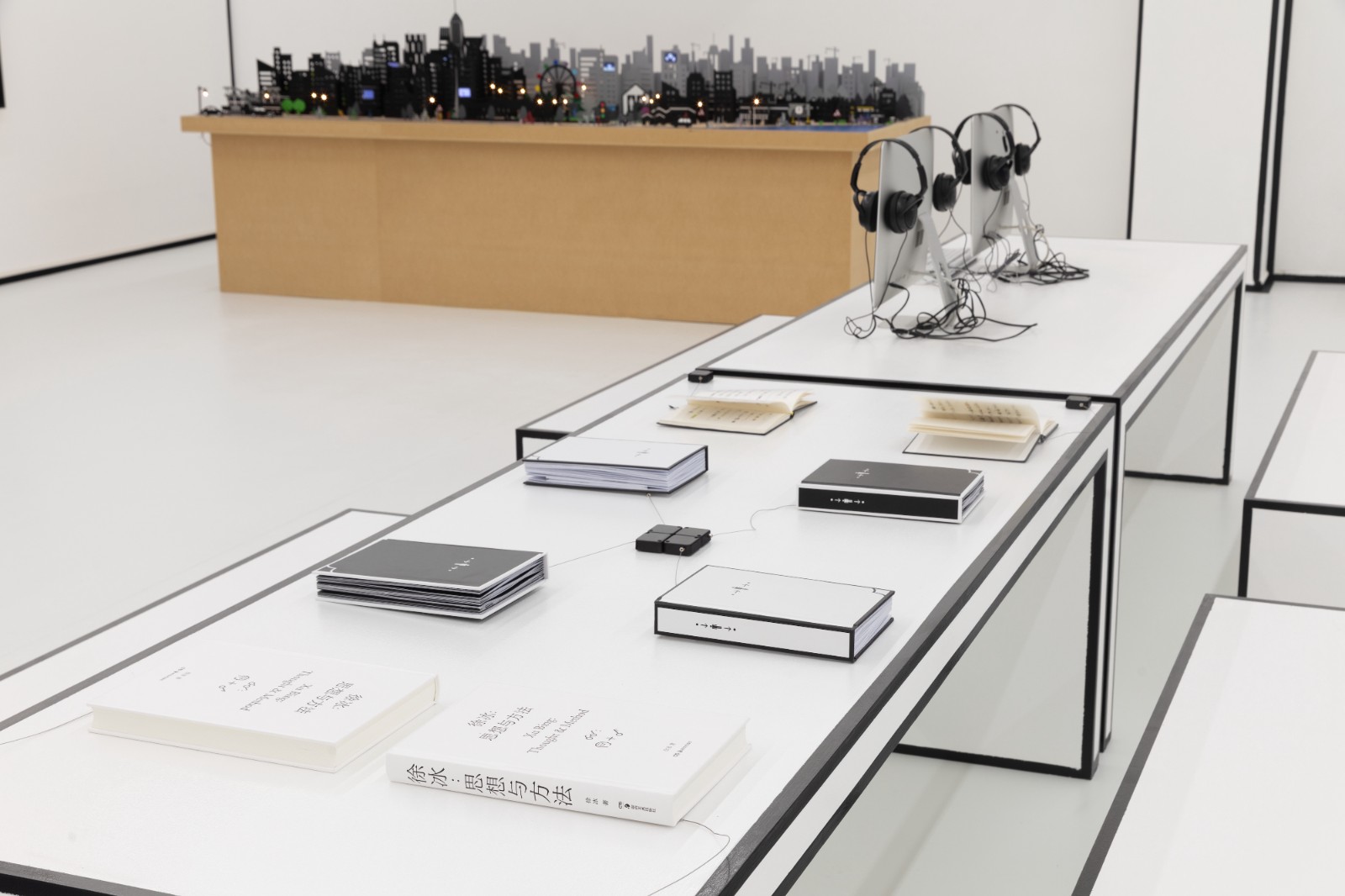
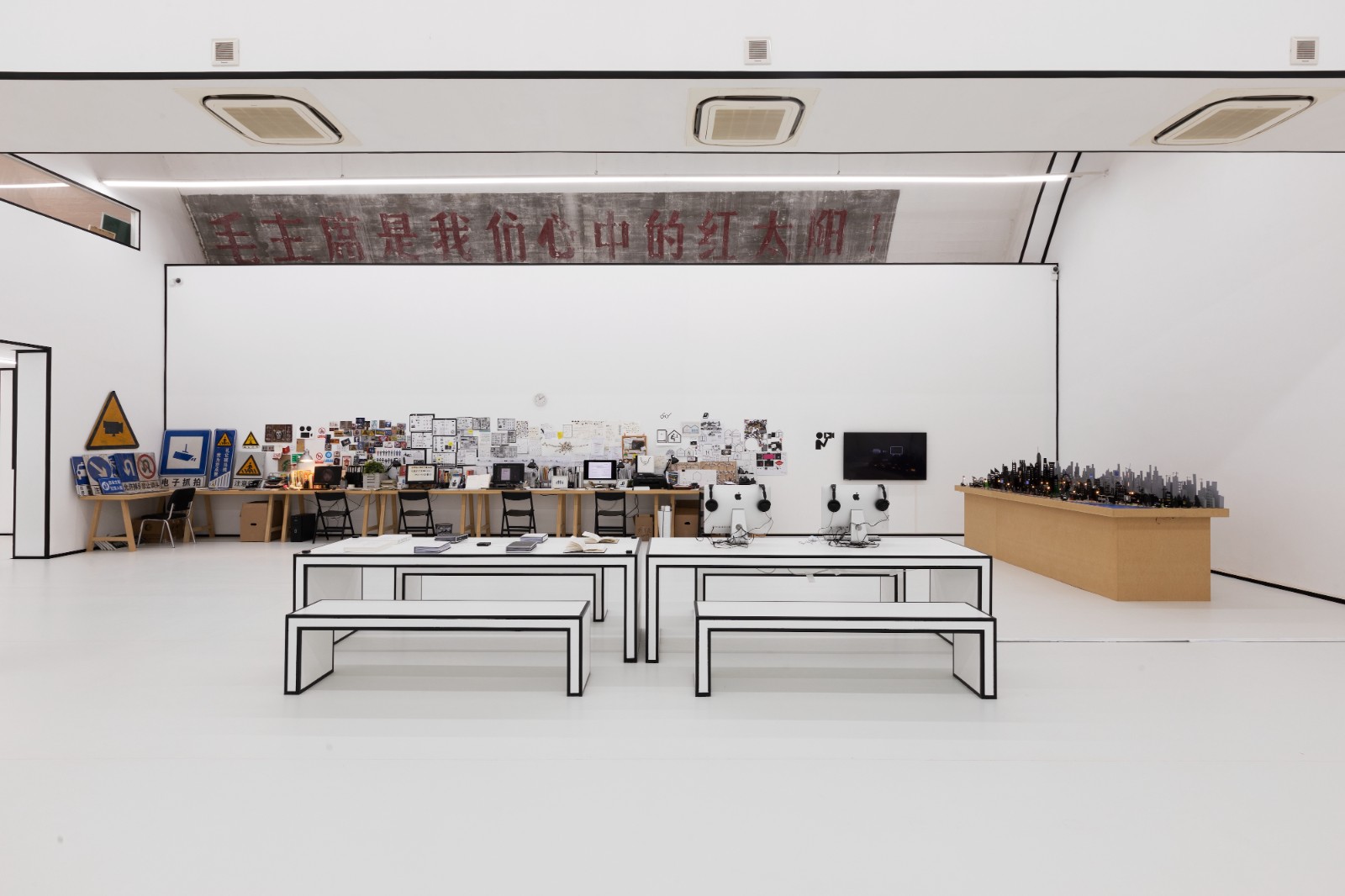
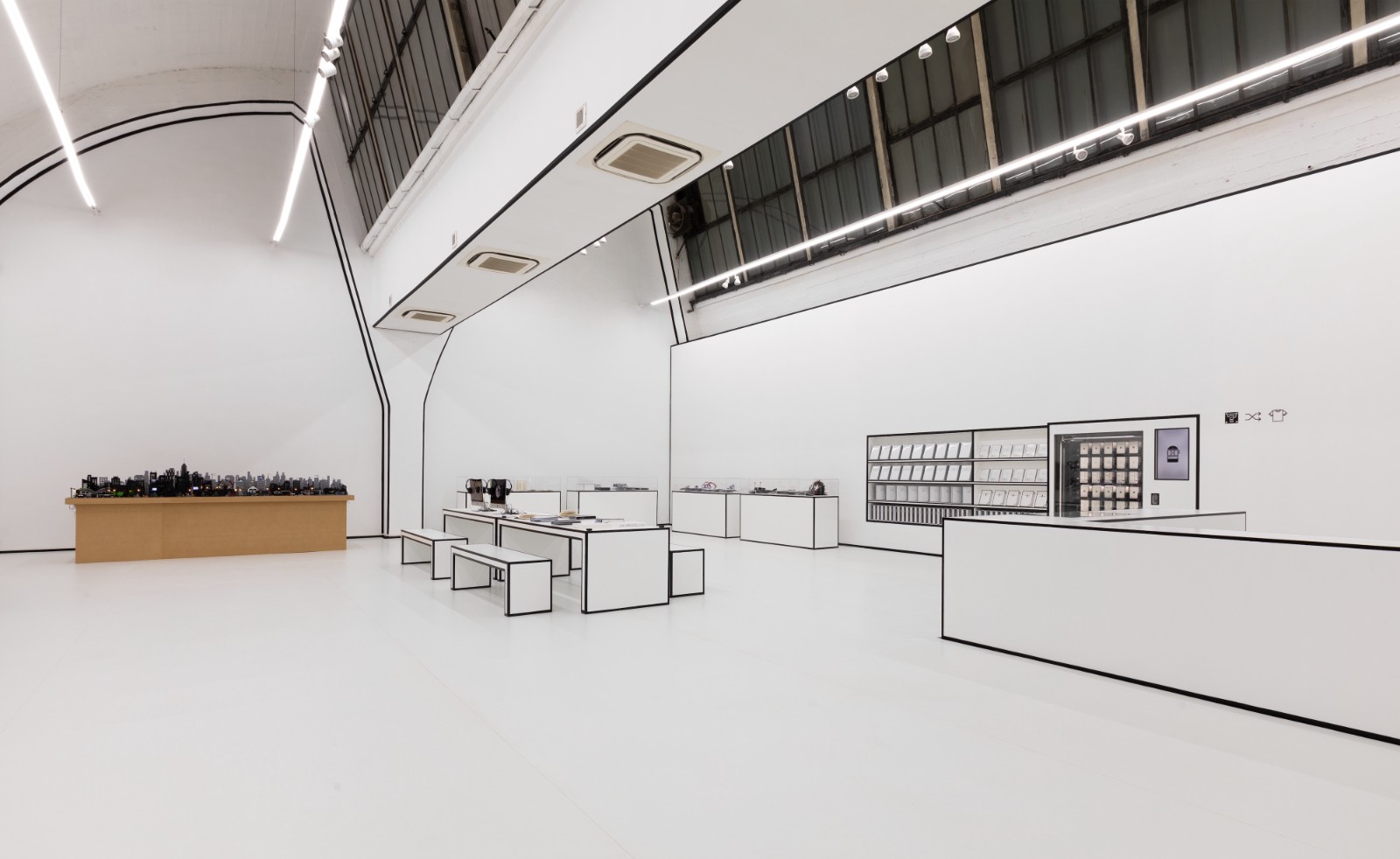
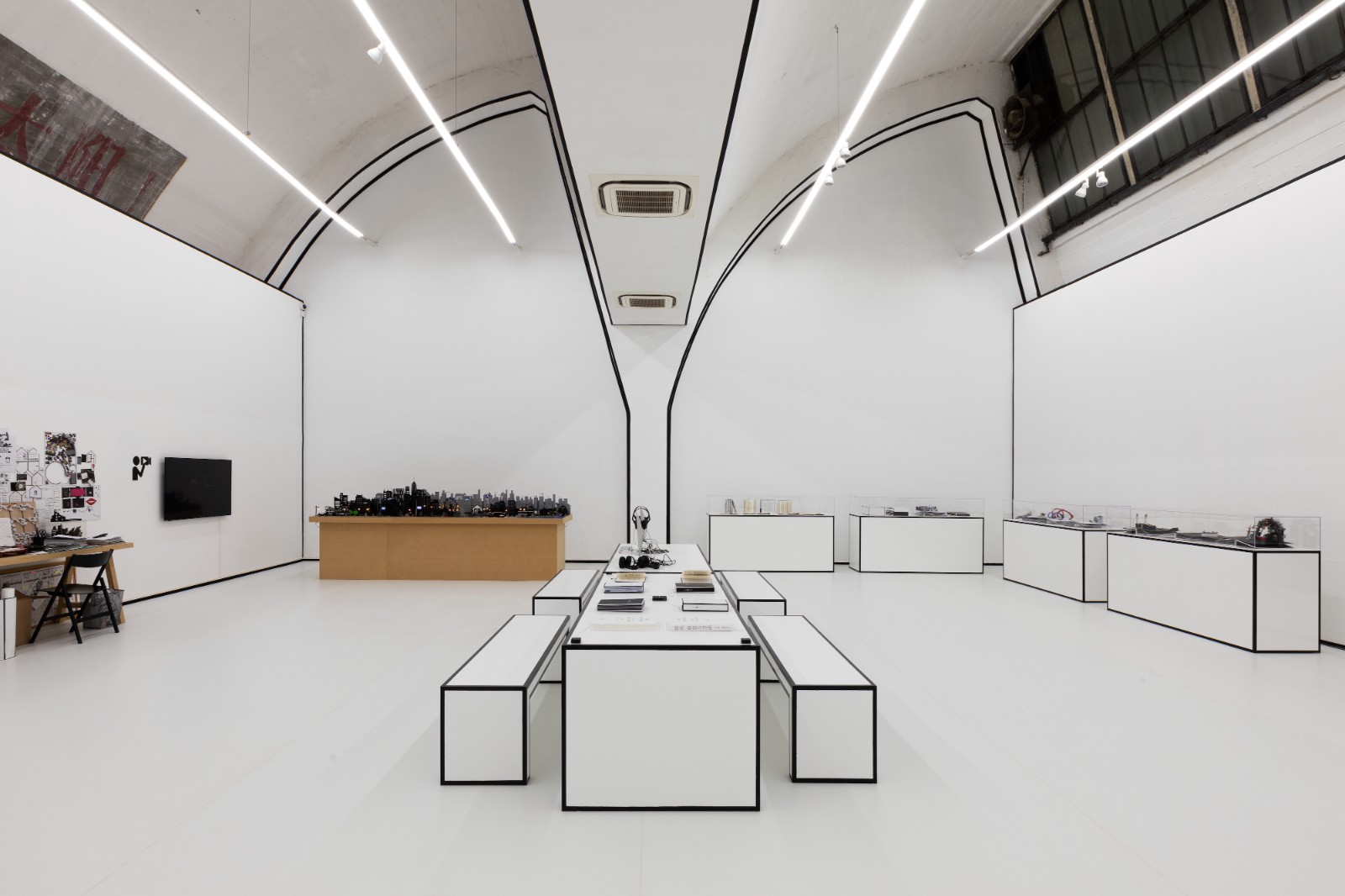
Installation View of “Book from the Ground—Pop-up Book”
The different schemes on the left and right sides of the exhibition hall inspire the spectators to find the corresponding relationship in min-games, from which they raise questions and express curiosity about the theme of this exhibition. The hints and “post-credit scenes” left by the artist for the attentive audience also reveal more details in the exhibition. All of these specially designed details actually point to the original intention of his creation, “Actually, I want to interpret such a truth, the symbolic world is replacing the real three-dimensional life.” This comprehension of current trends of the world, constitutes the core of the “Book from the Ground.” In Xu Bing’s view, human beings are heading towards the “meta universe.” In 1992, Neal Stephenson put forward the concept of “meta universe” in the science fiction novel Snow Crash, which received little attention thirty years ago, but it arouses intense attention from the internet field in 2021.
The so-called “meta universe” denotes that while putting on headphones and eyepieces, one can find the connected terminal, and enter a virtual space simulated by a computer which is parallel to the real world in the form of a virtual clone. “Meta universe”, in the context of intense discussions among internet giants, is a virtual space that can be entered through virtual reality (VR) and augmented reality (AR), and it points to the “future internet.” Entering the “meta universe” means that people can once again step into the “multi-dimensional space” blessed by high technology.
What’s interesting is that a certain judgement and attitude held by the artist towards future trends that were dominated by technology were finally implemented in a pop-up book with a long history and full of “low-tech” media.

“Book from the Ground—Pop-up Book”, large white book, 24.2×35.3×4.7cm

“Book from the Ground—Pop-up Book”, large white book, inside page
The reason that Xu Bing chose the pop-up book for the latest branch of “Book from the Ground” did not lie in the fact that he prefers “low-tech” pursuit to “high-tech” solution. Through previous artistic practices, Xu Bing began to realize that high-tech discussions usually cannot be separated from the participation of grand propositions such as art and technology. “High-tech methods tend to be complicated so that people cannot see the substantive layers. Instead, low technology allows us to better understand the essence of high technology, and their intrinsic quality is likely to be the same. In the current overall situation of the integration of technology and art, Xu Bing hopes to convey his perception of the current multidimensional reality through low-tech traditional media, as well as reflections on the future trend of “reading pictures” or even “comprehending symbols.”
From “Book from the Sky” to the artist’s book, and to the latest “Book from the Ground—Pop-up Book”, it is obvious that Xu Bing’s creations center around “books.” He attributed it to the reason that he has been immersed in “books” since his childhood, “If I read too much, my thoughts start to become unclear, as I feel that I have lost something...this unusual relationship with books is my characteristic I think...” Xu Bing shared his special relationship with pop-up books in the interview conducted by CAFA ART INFO, and he interpreted his thinking and unfinished aspects in the process that he has conducted in “Book from the Ground—Pop-up Book” over seven years.

Portrait of Xu Bing
CAFA ART INFO: “Book from the Ground—Pop-up Book” that was launched this time is a branch of the “Book from the Ground” project. What do you think that cannot be achieved by other media but did prompt you to choose a pop-up book to convey this?
Xu Bing: I have always been interested in printing and publications. I did mimeograph publications when I went to live and work in a production team in my early years. Later, I was interested in artists’ books, and I also created an exhibition on artists’ books. I think that traditional publication is gradually replaced by screen reading. Perhaps it has provided a new space and possibilities for artists’ books converted from paper media and produced by artists. I have a friend who opened an ancient bookstore in London. I once asked him whether it’s more difficult for him to sell old books, manuscripts, and ancient documents if few people read books and paper media now. My friend told me that in the digital age, people began to cherish certain types of paper media and paper books that can produce multi-dimensional pleasure and satisfaction. Still, we need more direct motivation for feelings. After all, the experience of touch-screen reading is a bit boring. In fact, you can also observe that many bookstores are beginning to transform themselves into gift shops, and books are transformed into multi-functional art derivatives.
As for why I choose pop-up books, in essence, many of my works have tried to create a barrier to people’s inertial thinking, and I hope that they want to adjust and return to a certain original state by summarizing the established knowledge or thinking system.
The benefits of pop-up books are also because first of all, it has a particularly low reading threshold. Whether it is a “Book from the Ground” or a pop-up book, children love it! What’s interesting is that I found that children read them very quickly, but high-intellectual adults read them slowly. In our life experience, it is common for adults to teach books to children, but in the face of the “Books from the Ground,” the situation is just the opposite, as children will teach adults. I think it’s because adults’ knowledge concepts are too strong, and pop-up books are closer to humans’ intuitive and primitive understanding methods. In the later stage of the pop-up book project, I discovered that many elements of contemporary art aren’t children’s crafts and games? In essence, it may be the same thing.
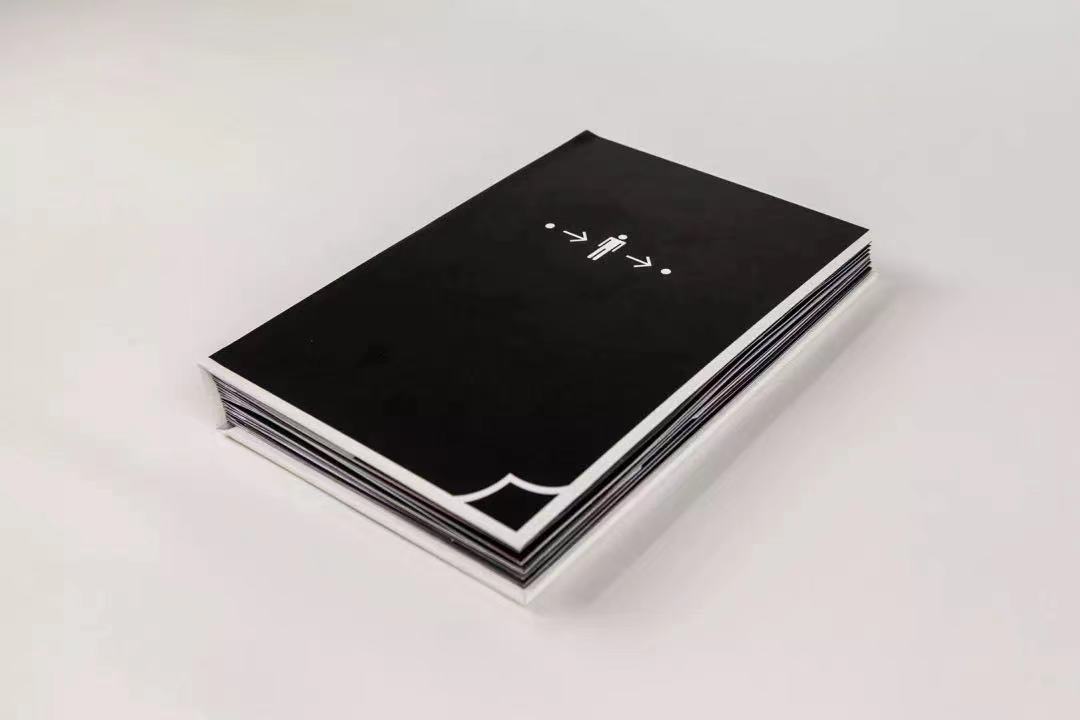
Book from the Ground—Pop-up Book, large black book, 24.2×35.3×4.7cm

Book from the Ground—Pop-up Book, large black book, inside page
Secondly, the expressions in many of my later works explored the area between reality and the unreal. For example, works such as “Dragonfly Eyes” and “Background Story” have similar discussion categories. At this moment, each of our lives has entered a multidimensional relationship. Everyone uses a mobile phone, and we are always “playing a two-man act” with mobile phones to show the world “who I am” and “where I am”. In fact, they are all “acts” and the content is not true. However, this multidimensional life is also a realistic life, but it is a life in another dimension.
This is why the “meta universe” has particularly stirred the nerves of the world recently. When American science fiction writer Neal Stephenson proposed this concept nearly thirty years ago, he did not receive such a strong response as it has now. Perhaps it is because the realistic lives of people at that time still lacked the facilities and systems that matched the concept of “meta universe,” and the world could not really enter the possibility unfolded around it. With the development of virtual reality technology, we may truly enter a purer multidimensional life directed by the “meta universe.” Based on the current situation, I hope to use the children’s thinking methods in the pop-up book to remind us to feel and think about the current multi-dimensional context, and to urge people to return to a certain starting point of cognition and to start it over.
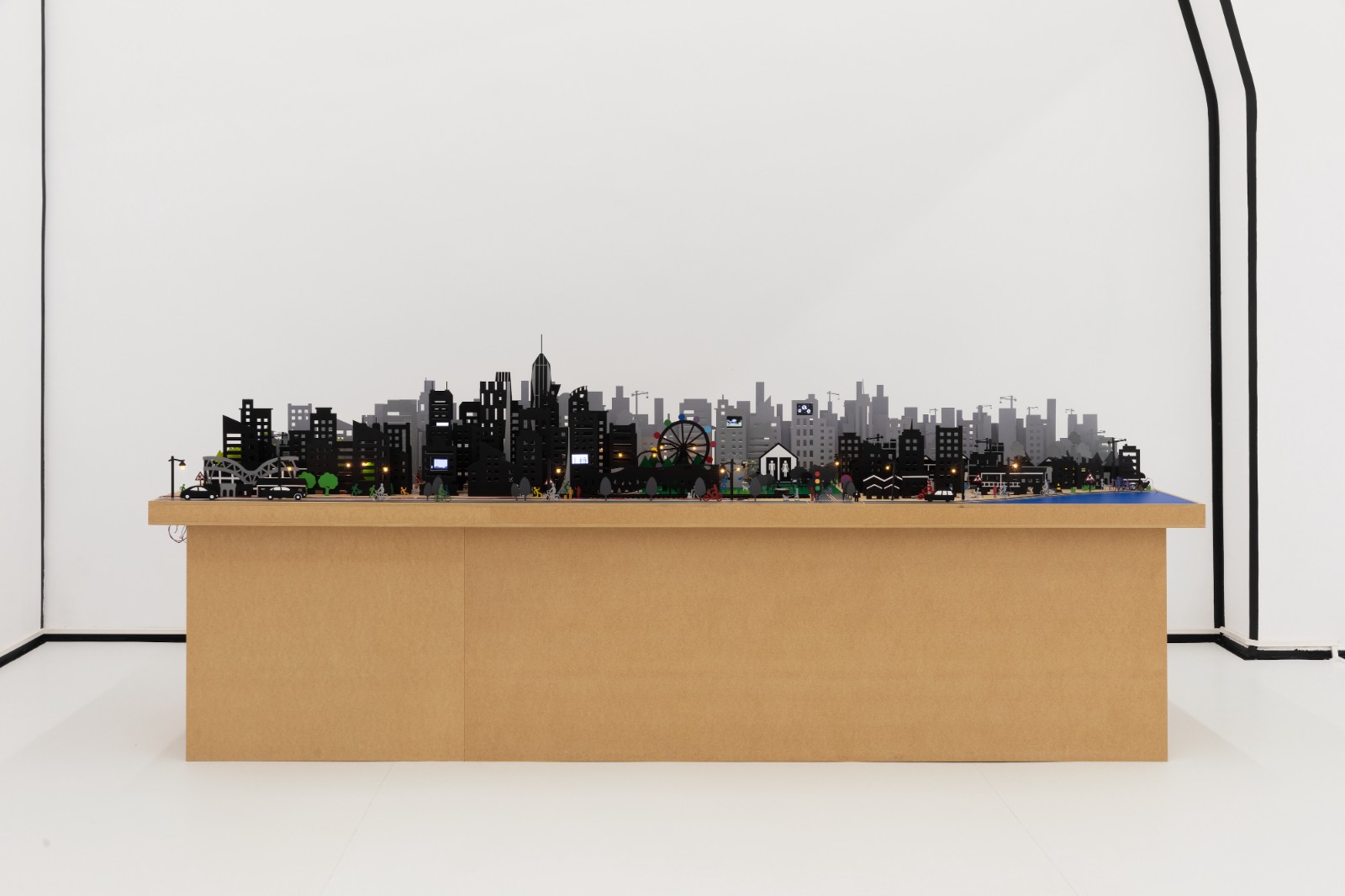
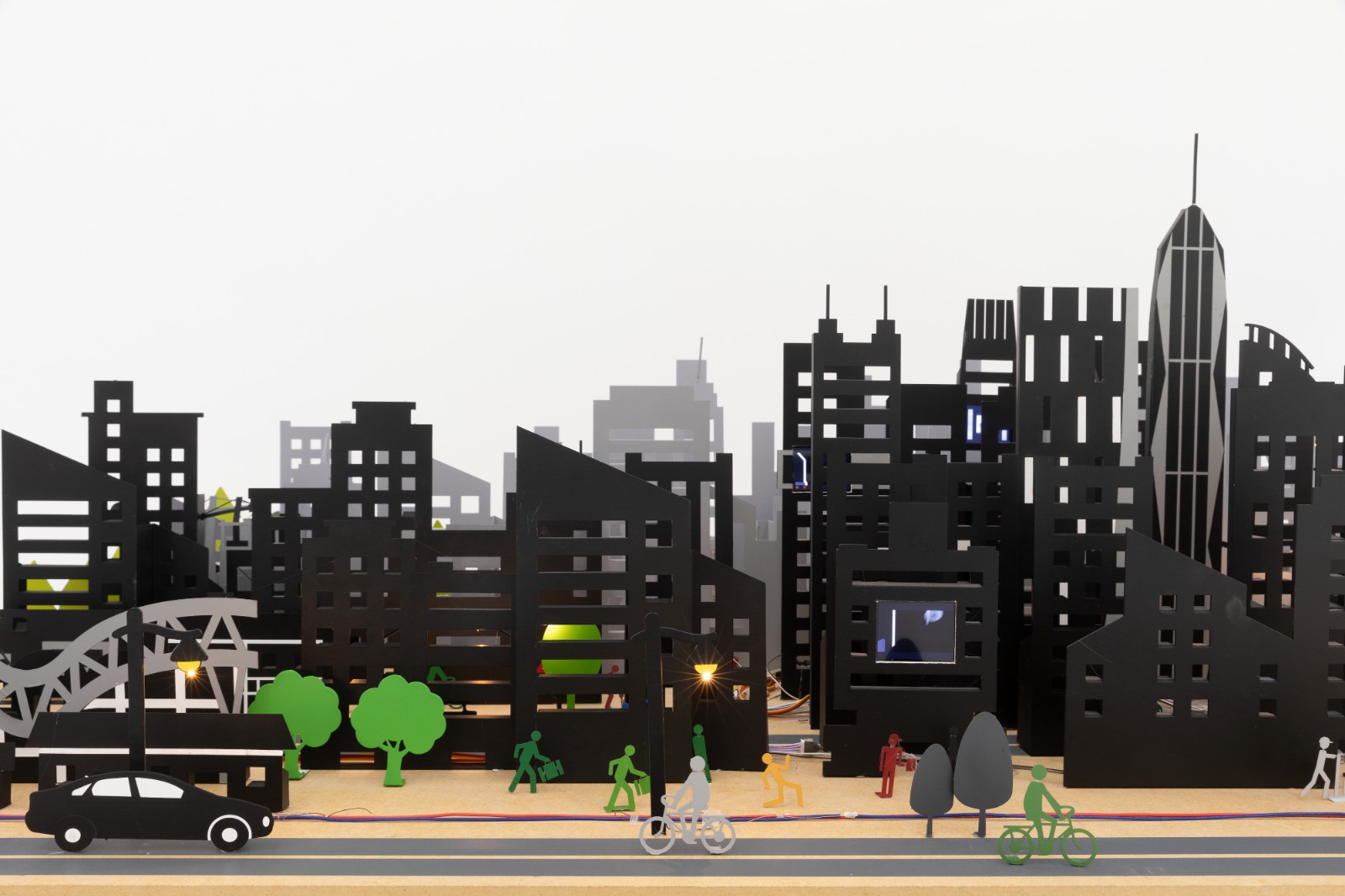
Exhibition View
CAFA ART INFO: Is this attempt at a pop-up book related to your previous statement on “don’t want to create any heavy stuff”?
Xu Bing: I don’t want to be too profound. In fact, I do not like “boasting” and I don’t want to make works that need to be explained with complicated theories. Theories always push the audience farther and farther. I personally think that, perhaps, in essence, Eastern thinking is not suitable for Western inferential thinking theories. Maybe people from the East and the West have different mental abilities? It’s just that Western culture is so strong that it requires us to add something we “miss”. For example, I am not very comfortable with Western theories, and I have tried to hit the books with others. After reading them, I ask how much I have experienced? It doesn’t seem to arise.
My own experience in practice is that one who can really understand a complex thing, on the contrary, he can use the simplest expression to explain what he gains. Without this ability, maybe it is not understood at all. In fact, the word correspondences in “Book from the Ground—Pop-up Book” are not simple, and it even requires a book to explain them, but it is easy for everyone to intervene in the world of “Book from the Ground.” Its surface is approachable and it inspires thinking. I like this approach works better than superficial poses. Complicated expressions or theoretical decorations will only make the audience feel inferior including me, so that I hope to make my own thinking as simple as possible, that’s enough.

The Chronology of “Books from the Ground” (partial)

The creative process of “Book from the Ground” displayed in the Studio Area
CAFA ART INFO: You always mentioned in interviews, including in your book Thought and Method, while emphasizing that your generation “has no knowledge and no culture”, but you have been making “books” and have been reflecting on knowledge and culture...
Xu Bing: A Belgian psychologist once told me, “The purpose of one’s life is to find what is lost.” This sentence made a deep impression on me. What have we lost? I think what we have lost may be something that civilization has taken away from us in the process of transforming us. All education and transformation of mankind actually obliterate what a child has and what a person should keep. In the face of civilization and knowledge, we must have some spirit of reflection.

Translated Editions of “Book from the Ground”
CAFA ART INFO: What is the position of narration in the “Book from the Ground” project and this pop-up book?
Xu Bing: This still needs to be discussed from the “Book from the Ground.” Conceptually, the content of the “Book from the Ground” is actually a storybook. I feel that our knowledge of stories and novels is always a bit limited, and I think that novels must describe things that are far from the ordinary life. In fact, the bizarre and unfamiliar are not the essence of novels. I think novels are about storytelling. In the “Book from the Ground”, I specifically emphasized a conceptual story, deliberately to combat something bizarre and the unfamiliar because stories beyond normal life are not necessarily wonderful, nor are they the essence of the stories.
In addition, I also hope to describe a very symbolic life in the book, so that the content of the story and the method adopted by the “Book from the Ground” can be mutually annotated. I did not use any of the characters invented by myself to write the “Book on the Ground.” Behind each of the symbols there is a corresponding consensus concept. I hope to use these symbols with a consensus to tell a highly standardized and generalized story, and finally form the most “standard” person of the moment. Of course, the scope of “standard people” covers all people who think that symbols of men and women on toilet doors can represent them. They are people who recognize the standardized symbols which rely on global industrial production and are spreading around the world, and they are also people who truly enter contemporary life.

The Concept Store
CAFA ART INFO: How do you feel when you read the book? Did you reach the preset goal?
Xu Bing: Sometimes I feel bored when I see so much contemporary art. Occasionally, when I see a piece of contemporary art that is particularly wise, well-thought-out, and perfectly expressed, it will arouse a great new interest. I sincerely feel that I still have to work hard, and the field of contemporary art is still very interesting! A similar situation also happened with artists’ books. When I was inspired by excellent artists’ books from others to stimulate my new feelings as well as interest in the world, I couldn’t help but sigh as there is such a smart thing in this world.
It took me seven years to make my own pop-up book, only to find that the production of the pop-up book is more difficult than it seems. It is a comprehensive product of craftsmanship, artistry and history, and it is contemporary art in books. Looking through the pop-up book I made by myself, I usually look for the problem first and then find its fault. Is this design reasonable enough? Is there a better and more interesting way of expression? Is it good enough? Is there a better or more interesting expressive way? Probably because I have a “fault”, I always demand that one thing must be absolutely in place, otherwise I will feel very uncomfortable and will subconsciously judge it. So I don’t read it too much now, as I want to make myself feel happier.
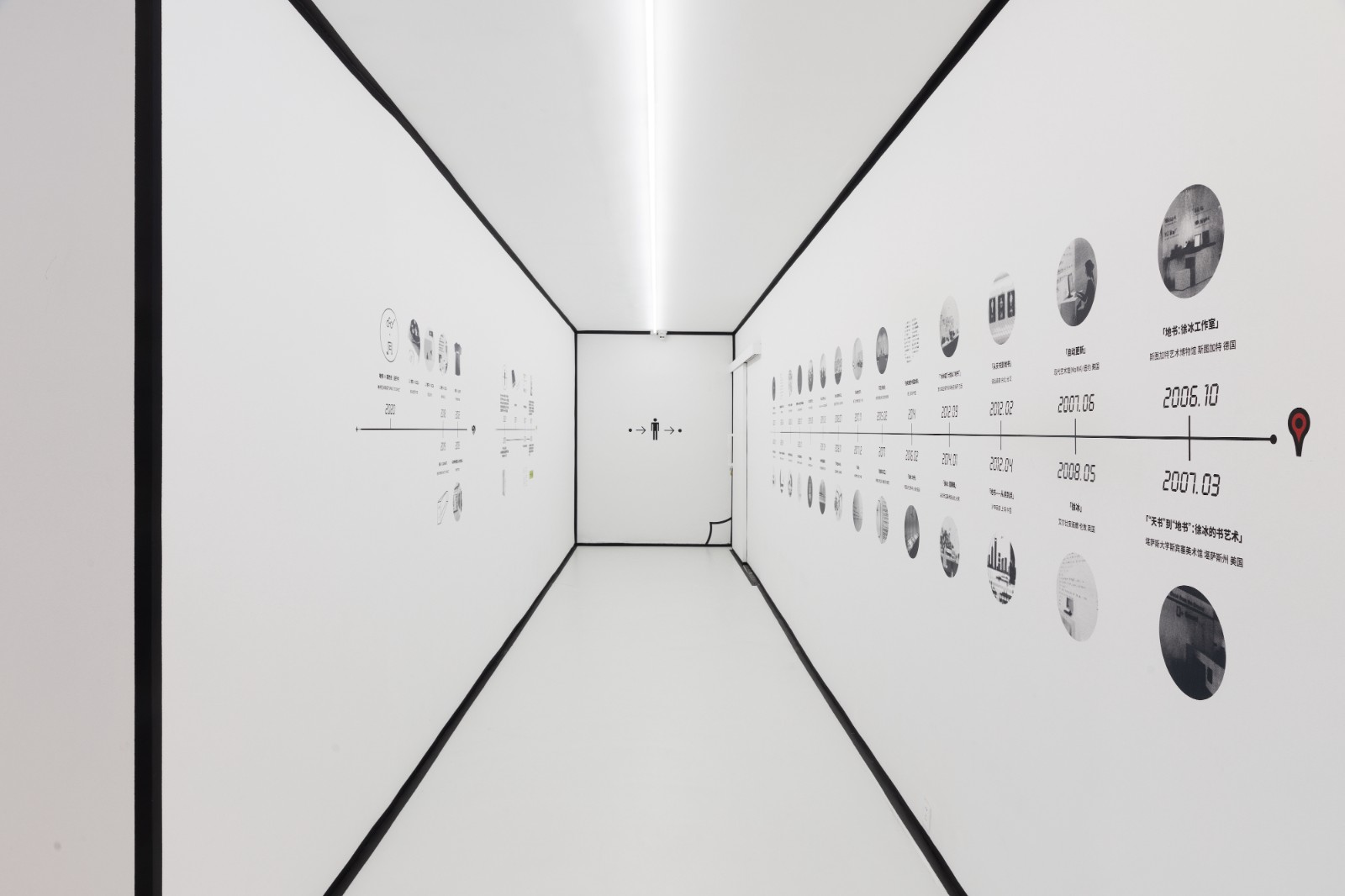
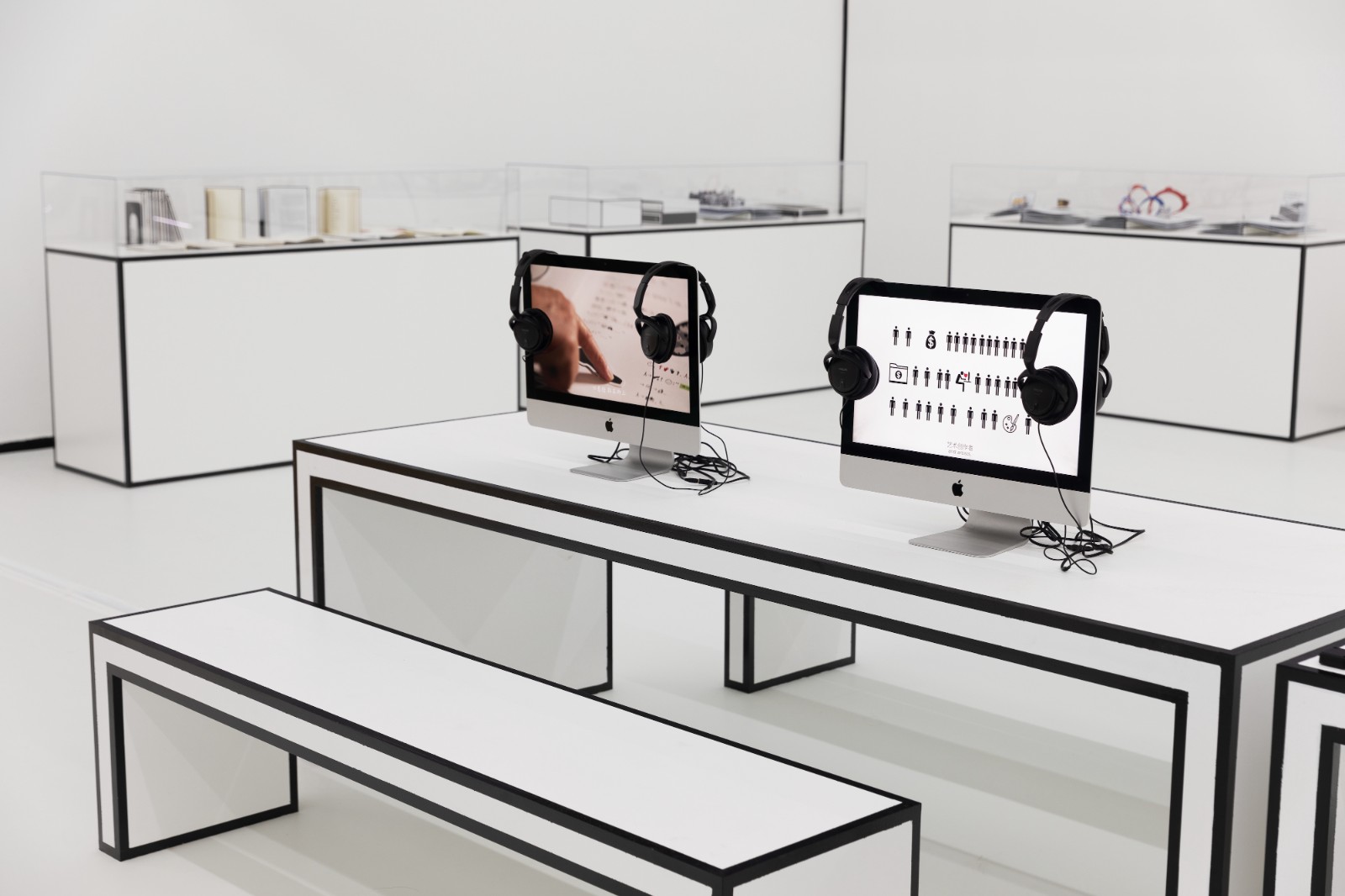
Exhibition View
I am pursuing absolute symbolization and absolute concise expression in the “Book from the Ground” project. I am afraid that this pursuit has no end. This is also in line with the characteristics of “Book from the Ground”, which is an unforgettable project. This is why I showed the studio scene in this exhibition. The materials of “Book from the Ground” are still changing, multiplying and growing. Along with the materials, the “Book from the Ground” is also growing, it has no end, in an “endless” way.
In art, I attach great importance to the growth of materials, on the contrary I do not pay much attention to art itself, as I pay more attention to the social scene outside of art. Such as, “Dragonfly Eyes” cannot be made when you have an idea, because there were not many surveillance images uploaded to the platform at that time. It was only conceptually established, but I know that “Dragonfly Eyes” is feasible as long as there are enough materials. The same goes for the “Book from the Ground” that started in 2003. When the idea of “Books from the Ground” appeared, there were only one or two series of universal emoticons in the world. With the deepening of globalization and the development of communication technology, the development of emoji and other symbolic expressions have been developed, and the “Book from the Ground” project has also grown.
The importance of material growth is also reflected as I later discovered that judging whether a writing system is mature does not depend on the quality of the system itself, but on the degree of cooperation between the user and the system. Around 2003, it was generally believed that emoji and other symbols were not suitable for complex expressions. After less than 20 years of continuous coordination between users and symbol systems, people finally discovered that emoji has an expression space that traditional languages cannot match. It’s like chatting with someone on WeChat at night, and one of them feels he wants to rest, but he is embarrassed to talk directly, and he sends a symbol of the moon, and the other immediately understands. This is how people adjust and supplement the symbol system in use. The “Book from the Ground” project has made more progress and gained more attention. I think it may be in line with a certain trend of human expression in the future.
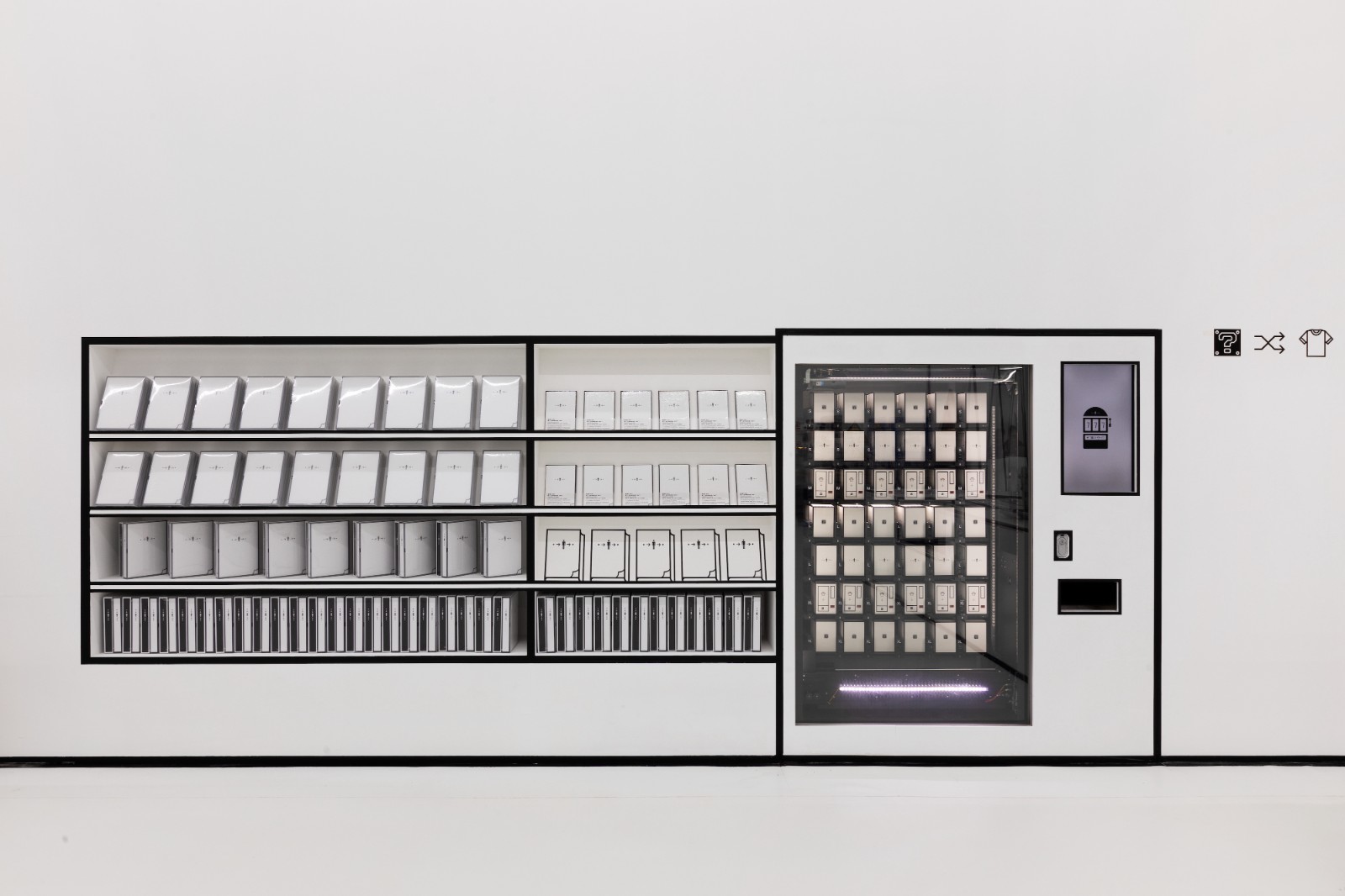

Exhibition View
CAFA ART INFO: “Universality” is reminiscent of the concept behind the invention of Esperanto. From 2003 to the present, along with the development of the project, is there any internal change in the “Universality” you emphasized in the “Book from the Ground”?
Xu Bing: I have always been interested in languages, and I have some understanding of Esperanto. I personally think that the key to the difficulty of promoting Esperanto is that it needs to be learned, and the biggest advantage of sign language is that it does not need to be learned. Beyond the cultural significance, from the perspective of language as a tool, the overall trend of writing is for convenience. From this point of view, simplified characters must be the ultimate winner, because it is simple and easy to learn. For example, there are two axes in your hand. One is an unearthed cultural relic with infinite cultural meaning, but lacks instrumentality, and the other is particularly sharp but has no cultural heritage. Which one would you use? There is no doubt that people will always choose the most convenient tools.
I also like to analyze our mother tongue from this perspective. At the tool level, the appearance of the text occupies a very important position, otherwise the art of calligraphy would be impossible to talk about. Many of my creations, including early art characters, etc., are actually done around the appearance of the text. Outside of Chinese, there is a lot of space for us to think and work.
The characteristic of sign language is that it is very suitable for the objective existence of the moment, and it is the most direct and counterpoint language. A symbolic cup skips the medium of language, and has a more direct relationship with objective existence. It can directly counterpoint with all languages, so it becomes an intermediate station for different languages, which is not available in any language. It can be seen that people start with pronunciation, and further develop from pictorial reading to reading symbols. Humans seem to become lazier, which also endows the picture reading with its own advantage.
Text by Mengxi, edited and translated by Sue/CAFA ART INFO
Image Courtesy of Tokyo Gallery + BTAP and Xu Bing Studio
References:
[1] Xu Bing, Xu Bing: Thought and Method, Changsha: Hunan Fine Arts Publishing House, January 2021;
[2] Xu Bing, Xu Bing: From Book from the Sky to Book from the Ground, Guilin: Guangxi Normal University Press Group, August 2020.
About the exhibition
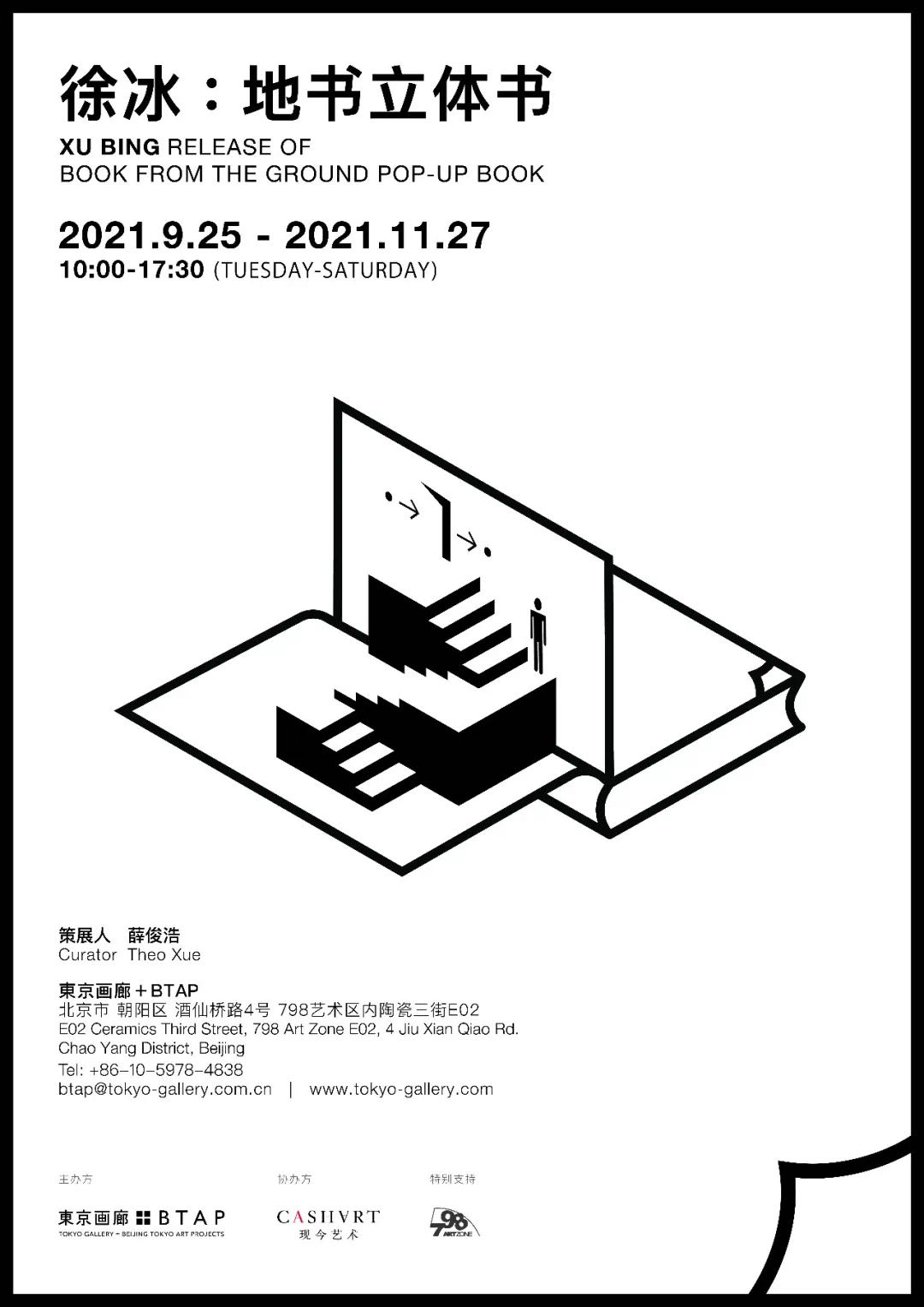
Curator: Xue Junhao
Organizer: Tokyo Gallery+BTAP
Co-organizer: CASHART
Exhibition Dates: 30 September, 2021-27 November, 2021
Exhibition Location: Tokyo Gallery+BTAP, E02 Ceramic 3rd St.798 Art Zone, Beijing




























